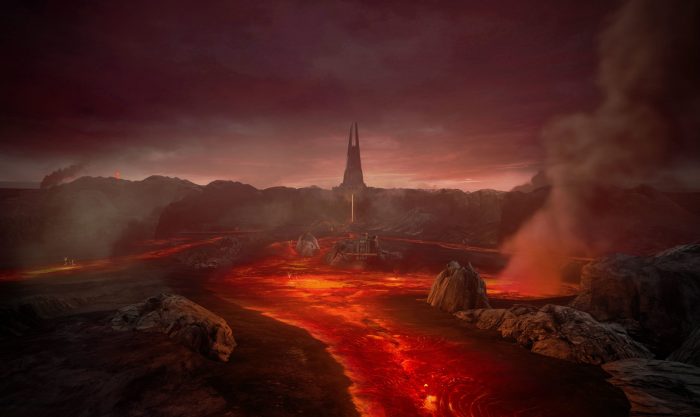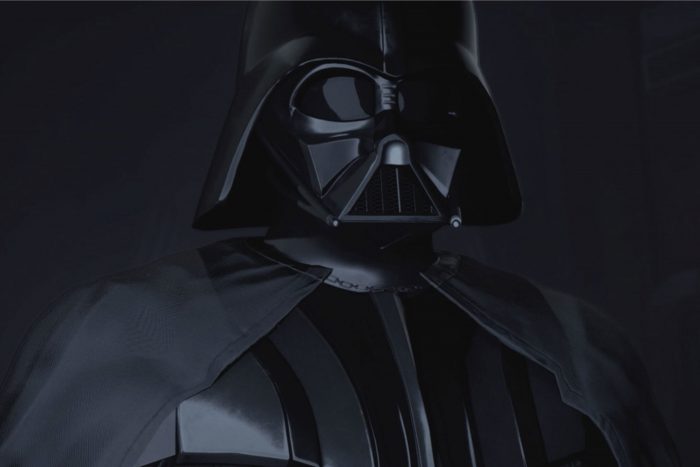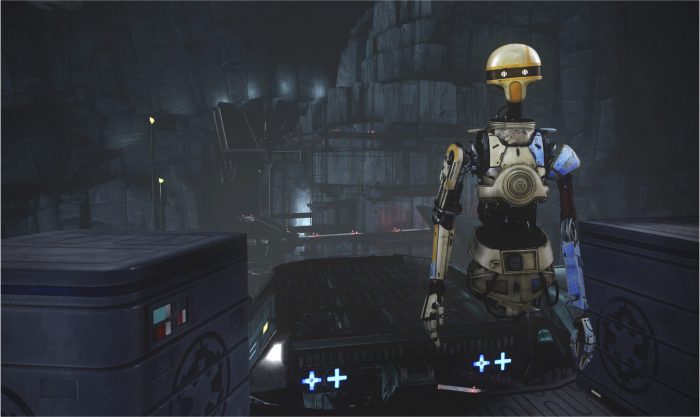David Goyer on the ‘Star Wars: Vader Immortal’ VR Experience and Adding a New Side to the Legendary Villain [Interview]
Earlier this week, I had the opportunity to sit down with Star Wars: Vader Immortal director Ben Snow, writer David Goyer, and executive producer Mark S. Miller to discuss their first big leap into telling immersive Star Wars stories in your home via virtual reality.
Immortal tells the story of a smuggler who is called to Mustafar, the volcanic world that Darth Vader calls home. What the dark Sith lord has planned for him, and what he is secretly working on in the dungeons of this castle, could forever change Star Wars canon.
After experiencing Star Wars: Vader Immortal for myself, I sat down to talk about the experience and how it was created.
Peter Sciretta: That was a lot of fun, guys. Why is this particular story best told in this VR format?
David Goyer: I think VR is really good at doing a number of things, giving you a sense of presence in a place and in an environment and making you feel empathy. Those two things. So we started thinking about from a fan standpoint, what would be an interesting place to explore into VR. And obviously inhabiting a Star Wars Universe is interesting, but so little is really known about Vader and so we thought it would be really interesting to explore where Vader lived and what he was doing when he isn’t necessarily doing the Empire’s bidding. So that was one thing. And then we also thought it would be interesting to see if we could get a little glimpse of another side of Vader, that you didn’t necessarily expect to experience. I mean, there’s the promise that it would be a little creepy, a little scary in this, you know, haunted house for lack of a better word, but we were also hoping there’s that sort of privileged moment when you’re kind of spying on him and we’re hoping that’s something that people don’t necessarily expect.
Ben Snow: And also, the other key story in here, is your story as the participant in the adventure. So it’s your story, and so really VR is the only way we can have you be the one.
I’m wondering like how does this come about? Like how do you develop the story? Does it start at the Star Wars story group? How does that collaboration work?
David Goyer: They contacted me first about three years ago and said, we’re thinking about doing something in the VR space, possibly with Vader. And that was the pitch. I mean, that was it. But they didn’t present me with a story. We just started kicking things around and, and while we were kicking things around, Rogue One hadn’t even come out yet. I had been up to the archives at Skywalker ranch and I’d seen some artwork, um, and whatnot that, some stuff that didn’t even make it to into the original movies. And there were some designs for Vader’s castle.
The Ralph McQuarrie stuff?
David Goyer: Yeah, exactly. And that was really intriguing. We started talking about that and then they said, hey, by the way, there’s this place in rogue one. And then they showed me some footage, which was cool. And we thought, oh, well, what if we set it in initially in the same place? Uh, in that film you only get to see one room. What if we expanded and it just kind of evolved naturally.
Mark Miller: And yeah, that was all with the story group. That was all hand in hand with them and a back and forth thing. Pablo and Matt Martin and, again with David’s help when we could set it and, when in the timeline and this just became the most intriguing part of Vader’s journey that we all were like, what the hell is he doing here? And, he’s not a soldier now. He’s a sith and what’s he up to?
David Goyer: And this before he learns about Luke.
Oh, this is before that. Yeah. Yeah, that makes sense. Obviously, this story seems to do with Vader trying to either bring back his lost love or communicate with her in some way and we see a glimpse of that in this first episode. We all know how the story goes, we know that she doesn’t come back. So how do you keep it dramatic with the audience already knowing that?
David Goyer: I was interested in, in trying to remind the audience of how Anakin was swayed over to the dark side in the first place. And that, that, I believe fundamentally, and this is just my belief, that Vader is committed to the Empire, but fundamentally he’s motivated by the sense of loss and this sense of remorse. And I was interested in exploring that. And there are some other characters that we’ll get into in later episodes that in a way Vader is kind of acting out echoes of that, and it’s sort of like the promise of what else the force could be capable of. We’re gonna learn more about the force and those promises and ladder episodes.
Ben Snow: And the question is, to gain what he wants to gain, how far is he willing to go? I mean, it is Darth Vader so he’s willing to go quite a way, all the way. Yeah, that’s intriguing as well.
This doesn’t quite seem like a video game, it’s not a movie.
David Goyer: It’s an immersive story.
So how do you define the rules of what you want that to be?
Ben Snow: We’re developing them. And I don’t think we definitely rejected the idea that there are rules that we definitely went through a process.
I can’t die. Right?
Ben Snow: No, no.
David Goyer: But that wasn’t a rule. That was something that we experimented with because it’s not a game. And the thing about when you die in a game and you reset, right? It pulls you out of the story.
It’s annoying.
David Goyer: And we didn’t want you to be pulled out of the story. And it’s not a game. Now there’s an outgrowth of this is the lightsaber Dojo, you know, because that became such a fun mechanic. These guys said we’ve got to make it into a separate experience, so that aspect is more gamified if you want it, but you diverge from the story.
There’s also some interesting stuff in this. Like, I’ve encountered Darth Vader before at Disneyland, but being in that hallway where you’re in close quarters and as he’s coming up to you it’s much more intimidating. It’s a sense that I’ve never kind of had before with them.
Ben Snow: Good, good. Well hey, we did it. It was funny because what David was talking about the genesis of this little bit, and one of the first versions of this was much more, you weren’t the central character in the story. You were essentially an observer on the story and it wasn’t as satisfying when Vader comes towards you and then turns and talks to some other guy standing next to him and you don’t have any involvement, you’re just watching this. And so that was something that we did initially and we said, well, actually this isn’t as satisfying as we would like because we feel like we’re at a party and the person you want to chat to is actually chatting to other people and ignoring you completely.
David Goyer: We were talking about this and in another instance, but in a movie, right? Or television show you’re removed from the story, which is not to say you’re not engaged, but you removed from the story.
You’re not immersed in it. Your third person.
David Goyer: Yeah. You can watch an intimate conversation, but you’re not picking up any social cues from the movie, right? If you’re at a party, as Ben was alluding to, and the three of us are having a conversation, and then after a moment you just start talking to Ben, ‘m going to walk away at a party or I’m going to tune out or I’m going to get a drink or something like that. And what we started to realize is that, that those kind of apply, there’s social cues apply in VR as well. And so that’s why we realized, Oh my God, we really have to be engaging with people. Vader has to be talking to you. Other characters had to be talking to you because it’s VR is so immersive that you check out you, you start to feel like they’re being rude, that they’re not addressing you.
Ben Snow: Yeah. So sort of circles back to your first question then. It’s like we wanted to make the story relevant as something that you would want to experience in VR and making it your story was really important in that regard. And giving you interactions with characters and interactions with the world around you is really key as well.
One thing I think a lot of Star Wars fans, are craving with all this expanded content outside of the movies is for that content to somehow interact or inform…
David Goyer: To matter?
Yeah to matter. I mean, I read these books and then almost nothing of it matters to the main story or it doesn’t give me any insight on the main story. Like, so how is this story going to matter?
David Goyer: Well, the intention though, the part of the reason that we interact with the story group is for that reason. I mean in little tiny ways, it’s already started to trickle back into things. Some stuff is trickled back into the comic books and into Lego mini figures, you know, things like that. But the hope is, there was a lot of debate if this thing, is it in canon, is this not in canon? It is in Canon. And it’ll be really cool if some of these characters show up on the TV shows or movies or things like that.
Mark Miller: No, they were very much from the start. Uh, Kiri Hart back then was very much like, if we do this, this now becomes his story. This becomes part of his story as much as the movies. So we have to be careful and we have to make sure that we hit the right beats with it.
Do you guys have discussions beyond the story group, with like filmmakers that are making stuff now? Like Favreau or Abrams?
David Goyer: We’ve had some discussions with them about things that we were putting into our thing, but no one’s been able to see our thing yet, so it will probably happen moving forward.
Mark Miller: We talked to all the filmmakers back when we first started from Gareth and everyone, about what the plans were.
What do you think the biggest challenge of this whole endeavor is? I mean, it seems like you’ve guys have been working on this for a few years now.
David Goyer: I was a minor when we started. (laughs) I mean, It’s interesting because there were a lot of serendipitous things that have happened. I mean, when we started, we didn’t even know a wireless headset was like on the horizon. Yeah. And so once that became a possibility, it opened up a lot in terms of not just the mechanics of what we could do, but, I believe personally, the wireless headsets make people more comfortable. We’re staying in the experience for a longer period of time. And so I think that that expanded greatly the length.
Ben Snow: Yeah, when we started, people were throwing around numbers like 10, 12 minutes and you know, that’s, that’s what people could take in VR. But as experiences started getting longer, we were like, no, you can get lost in there. And we want to give people that chance to do that. Also, it’s going to make it more accessible to more people. You don’t have to have a massive computer or anything. It’s a standalone. You can just download the things wirelessly onto the headset. So I think that that’s going to make it way more accessible.
Mark Miller: And I think the biggest challenge that I was concerned about was the lightsaber fighting, being good enough. And just when we first started just going, oh, this can’t work because the haptics and everything doesn’t work. And then early tests just started telling us, okay, it might, but it’s something that we’ve refined from day one. All the way from Trials on Tatooine all the way up to now.
David Goyer: Yeah. That really advanced. It’s been interesting because there’s been a feedback loop between the technology evolving as we’re building this thing and making more things possible. And then us hurrying up to go like, oh crap, well let’s do that too. And that’s been really interesting. And then what we hope will start happening is that a broader audience would experience this and will be coming to like these wireless headsets then ever before. And so we were also very cognizant of let’s not just build this for early adopters and hardcore gamers. Let’s try to build this for a broader audience. And I think it will be interesting to see, I was talking about this the other day, you go back to the early days of film, and you know, for instance, the rhythms of, of, of editing and film have changed over time. Just or from going the talkies to then like how long a cut can be our long a scene. But that will change with VR too because the audience will start to, the gestures and the way – I was just talking earlier about how when iOS Games first came out and there were certain gestures that have now become second nature to us, right? But none of, none of that’s really been learned by the broader audience. So it’ll be interesting as this hopefully starts to seep into the world and they sort of take that in. I think things will become more and more intuitive. So some of what we’re doing in this first episode was also kind of a tutorial.
Continue Reading Star Wars: Vader Immortal >>
The post David Goyer on the ‘Star Wars: Vader Immortal’ VR Experience and Adding a New Side to the Legendary Villain [Interview] appeared first on /Film.
from /Film http://bit.ly/2JaYIBv




No comments: